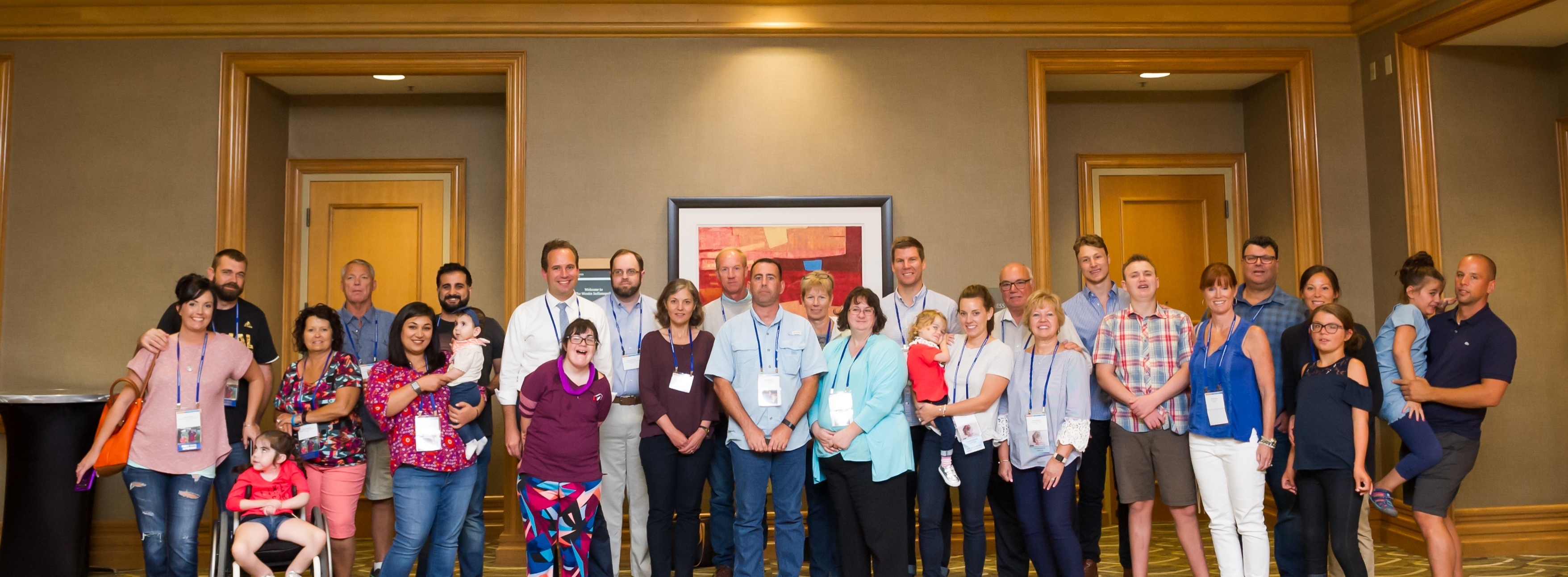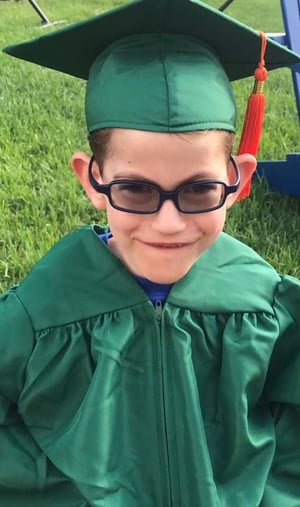 With the input of experts and parent advocates from the SYS community, a research plan has been developed to guide and accelerate SYS research over the next 3 years. The plan includes a brief overview of the ‘current state of research,' highlights current opportunities and needs, and identifies and prioritizes key research questions.
With the input of experts and parent advocates from the SYS community, a research plan has been developed to guide and accelerate SYS research over the next 3 years. The plan includes a brief overview of the ‘current state of research,' highlights current opportunities and needs, and identifies and prioritizes key research questions.
If you have a loved one with Schaaf-Yang syndrome, learn more about our SYS research plan and get involved as we work together to advance research towards treatments, and a cure for SYS.
Schaaf-Yang syndrome, first identified in 2013, is a rare genetic disorder affecting multiple systems. SYS is caused by mutations in the MAGEL2 gene, which located in the Prader-Willi syndrome (PWS) region of chromosome 15.
Many clinical features of SYS are similar to PWS, including hypotonia (poor muscle tone), feeding difficulties in infants, developmental delay/intellectual disability, behavioral problems, poor bone health and endocrine abnormalities. However, additional features are more common in SYS than in PWS, such as contractures (rigidity of joints), autism and severe intellectual disability.
The full spectrum of SYS features remain to be defined, and the natural history of the disorder is incompletely characterized. Further, while cellular studies have identified a role for the MAGEL2 protein in “recycling” functions in the cell, the normal function of this protein is not well understood, and it’s not yet clear how disruption of its function leads to the characteristics of SYS. Finally, optimal standards of care have yet to be established for individuals with SYS, and novel therapeutic interventions have yet to be advanced.
Next steps to advance SYS research:
- Generate antibodies for MAGEL2 (2019)
- Generate cell models (2019)
- Develop ‘assays’ on cells that can test the function of the MAGEL2 protein (2020/2021)
- Carefully characterize MAGEL2 animal models (2019-2021)
- Collect Patient Experience and Natural history data (2019-2021)
- Develop a GH study for SYS patients (2019/2020)
What is the current state of SYS research?
Patient Perspective
- Current care includes typical early intervention for individuals with developmental disabilities: physical therapy, occupational therapy, speech therapy.
- Family concerns include developing standards of care to improve clinical outcomes and to help with reimbursement issues. There is a need for evidence-based clinical care guidelines.
- Growth hormone (GH) replacement therapy is being used by some families, but little is known about optimal dose, appropriate age for initiation, and how to manage GH therapy in the context of sleep apnea, which can be a significant finding.
- Developing/accessing effective interventions to improve speech, communication, intellectual development are also a high priority.
- Sleep disruption is also of concern to families.
- Behavioral challenges that have overlap with the PWS behavioral phenotype (eg, anxiety, obsessive compulsive behaviors, cognitive rigidity) may be present in older children.
- Novel therapeutics (eg, oxytocin) are of interest to families.
- To date, the understanding of family concerns, unmet needs and disease impact are based primarily on anecdotal experience; a more formal assessment of the scope of needs and concerns of SYS families has not yet been performed.
Clinical Aspects of SYS
- Currently 150+ SYS patients have been identified – there are likely thousands of SYS patients, but identification of all SYS patients has been slowed as it required advanced genetic testing.
- “Natural history” studies of SYS, defining common features of SYS, as well as the spectrum of severity of medical complications and clinical outcomes, are at an early stage. Much more work is needed to understand the full spectrum of SYS and the expected outcomes.
- Neonatal hypotonia with feeding problems in infancy, sometimes through childhood is extremely common in SYS.
- Abnormalities of the endocrine system, including growth hormone deficiency and elevated levels of the ‘hunger hormone’ ghrelin, are common.
- Developmental delay, intellectual disability and autism spectrum disorder are consistent features of SYS cases described to date, although severity varies widely.
- Additional features present in many/most individuals include respiratory distress, sleep apnea, other sleep disturbances, gastroesophageal reflux, constipation, temperature instability, hypogonadism and joint contractures.
- Scoliosis and poor bone health are common and need to be monitored carefully.
- Optimization of care is needed for GH therapy, other endocrine system problems, bone health, apnea, sleep.
Molecular Genetics
- To date, only “truncating mutations”, or mutations that shorten the MAGEL2 protein, have been described. This is unusual in genetic disorders; most genetic disorders have some patients with “missense” mutations, or mutations that change because of a subtle change in the protein. It’s not yet clear if there are missense mutations that cause SYS – this has been complicated to determine.
- To date, there is not a strong correlation between where the mutation is and how severe the SYS characteristics (the ‘phenotype’). It may be that some truncating mutations cause loss of the MAGEL2 protein, while others cause the protein to behave differently (“gain of function”). This is an important point to sort out.
Cellular Biology
- MAGEL2 functions in a protein complex (with the proteins TRIM27 and the USP7) to regulate the “recycling” pathways in the cell.
- A role for MAGEL2 in recycling certain cellular receptors has also been described.
- Additional interacting proteins are being defined/investigated
Animal Models
Two different mouse models of Magel2 deficiency have been widely used to by scientists to date.
- The first model (Kozlov, 2007 Nature Genet) has been used to define disrupted pathways (sleep/circadian rhythm, brain chemistry disruptions, hypoglycemia, activity, body composition, muscle, oxytocin) and evaluate potential therapies (oxytocin, endocannabinoids, diazoxide, OEA, setmelanotide).
- A second SYS mouse model {Schaller, 2010}, has been characterized, and these mice show impaired feeding with poor suckling, higher mortality after birth, and social and cognitive deficits. Administering oxytocin improves these characteristics.
- At least three new mouse models are in various stages of development by scientists, and FPWR has developed a rat model of SYS, which is currently being characterized at Baylor College of Medicine.
Therapeutics
- Application of drugs/devices/supplements that are FDA approved /available or are in development to SYS. Examples: Growth hormone, oxytocin/carbetocin [Preclinical and clinical development].
- A number of other compounds (some FDA approved, some not yet approved/available) have been tested in mouse models of Magel2 deficiency.

What is needed to advance SYS research?
Research Tools needed:
- Antibody to MAGEL2
- Well characterized iPS cells
- Other cellular models: models of muscle and bone changes in SYS
- Functional assays – of MAGEL2 protein function
- Additional animal models to answer feasibility questions about SYS molecular interventions
- Biorepository of dental pulp stem cells, other patient specific cells
- Proteomic analyses – to assess what are the protein changes that result when MAGEL2 is not in functions
What needs to be done before we can begin SYS clinical trials?
- A patient registry to obtain better natural history data and support clinical trials is needed
- An understanding of current barriers to evaluating novel interventions should be performed – e.g., identification of patients, lack of natural history data, clinical expertise, lack of standards of care, reimbursement issues, etc.
- Using the registry or other approaches to understand what interventions families are currently doing, with a plan to provide families with a way of documenting outcomes as rigorously as possible, using common measures.
- Collect “patient experience data” to support the industry in the development of new therapeutics, as per the FDA patient focused drug development initiative. These studies should define the patient perspective on the impact of SYS on the individual and family, as well as document efficacy and limitations of current therapies available to individuals with SYS, and define unmet medical needs.
- Symptoms: endocrine (GH deficiency, other), sleep disturbances, behavior, ID, bone, GI issues. Sampling of the entire population will be important to gain an understanding of the scope/variability of needs.
- Development of a ‘first clinical trial’ for SYS patients – for example, a trial of GH therapy in SYS.
What are our outstanding research questions for SYS?
Outstanding research questions
- Top priority: “Genotype/Phenotype”: Need to definitively determine if SYS is caused by loss of MAGEL2 function or if a “gain of function” is associated with some mutations. Understanding the basis of phenotypic variability in SYS (mutation/phenotype correlation).
- How does mutation of MAGEL2 impact other genes in the region (eg, are there changes in expression of other genes in the PWS region that may be contributing to SYS characteristics)?
- Understanding basis of intellectual disability in SYS: cellular and pathway changes as well as connectivity/structure/developmental changes in the brain.
- How are other brain/neurotransmitter systems altered during development in the absence of MAGEL2?
- Defining cellular changes that are consistent patient samples, and lead to clinically important characteristics.
- Functional (cellular) assay to evaluate new mutations and for drug screens.
- Is there are convergence in the function of MAGEL2 and other PWS-region genes?
- What is the role of MAGEL2 in peripheral organs?
- Clinical evaluation of sleep, sleep maintenance and/or circadian health in humans with SYS
Molecular therapy for SYS
- Evaluate the feasibility of genetic therapy for SYS including gene activation (activation of maternal MAGEL2; overlaps with ongoing efforts in PWS), genetic delivery of a functional MAGEL2 gene, and the use of CRISPR technology for MAGEL2 gene editing.
- Address general feasibility questions, such as whether the characteristics of SYS can be reversed in infancy, childhood, adulthood; what level of MAGEL2 function needs to be recovered to impact the SYS characteristics; what are possible side effects of molecular therapy.
What are our next steps?
 Generate antibodies for MAGEL2. This will help scientists visualize the function of the MAGEL2 protein.
Generate antibodies for MAGEL2. This will help scientists visualize the function of the MAGEL2 protein.
- Generate cell models. By using advanced genetic techniques, There can be stem cells generated that have common SYS mutations to understand how these mutations alter the function of the MAGEL2 protein.
- Develop ‘assays’ on cells that can test the function of the MAGEL2 protein. This will be critical for screening drugs that might overcome the deficits that happen in the cell when MAGEL2 is not functional.
- Carefully characterize MAGEL2 animal models. In order to understand how loss of MAGEL2 function contributes to clinical characteristics. Well characterized animal models will also be critical for testing new drugs and genetic therapies
- Collect Patient Experience Data and SYS Natural history data to support the development of new therapies.
- To develop survey for caregivers on most challenging symptoms, current therapies, unmet needs, impact.
- To promote enrollment in patient registry.
- Develop a GH study for SYS patients.









